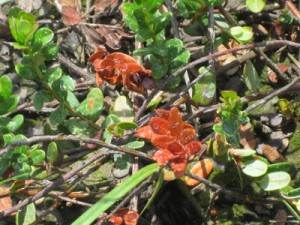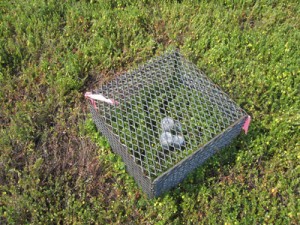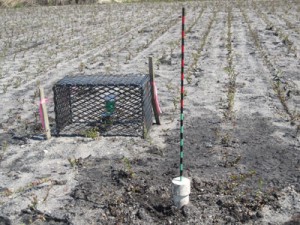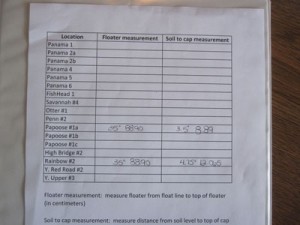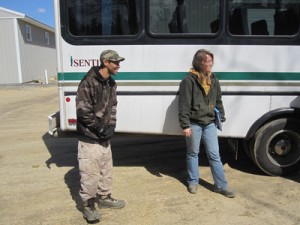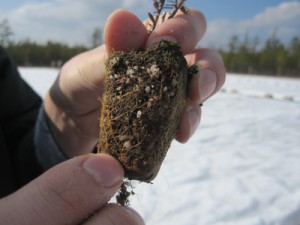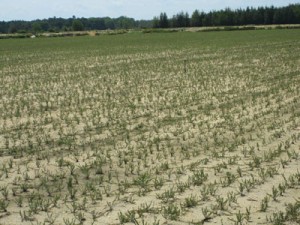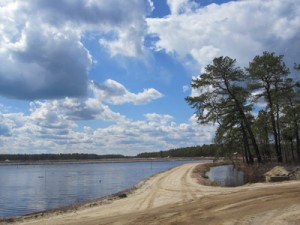A good irrigation plan manages the volume, frequency, and application of water in an organized and efficient way. A clean abundant water supply is only the first step in Pine Island’s water management program; a detailed irrigation routine is also crucial to our goals.
A cranberry crop’s needs are met in three ways: rain, irrigation, and soil contribution. Unfortunately, farmers have yet to find a way to control the weather, so they must turn to the things that they can control. As it turns out, a study by Bruce Lampinen showed that for many weeks during the growing season, most cranberry beds were too wet. This can especially be a problem in the humid climate of southern New Jersey, and if not dealt with, can cause conditions favorable to fruit rot and root rot. Cranberry beds usually receive up to one inch of water per week from either rain, capillary action from the ground water, irrigation, or a combination of all three. But as conditions can vary from bog to bog, this does not always result in ideal soil conditions.
We have mentioned before our use of tensiometers in monitoring soil moisture. (From UMass: “A tensiometer is a sealed, water-filled tube with a vacuum gauge on the upper end and a porous ceramic tip on the lower end. A tensiometer measures the soil water potential in the soil. As the soil around the tensiometer dries out, water is drawn from the tube through the ceramic tip. This creates a vacuum in the tube that can be read on the vacuum gauge. When the soil water is increased, through rainfall or irrigation, water enters the tube through the porous tip, lowering the gauge reading.”)
Lampinen’s study showed that maintaining a water table beneath the bed a sufficient depth to provide water to the root zone by capillary rise while avoiding oversaturation in the root zone, irrigation needs can be met. In order to best measure this, he designed a water level float, or lampinometer, which can be easily assembled using parts from various hardware, plumbing, or garden supply stores, making it an economical choice for growers. The lampinometer is not only less expensive, it also requires less maintenance and is more sensitive to water table fluctuations. (Study.)
Vanessa DeJesus and Casey Koehler started working on the tensiometers two weeks ago. “I basically just make sure the plants have enough water,” Vanessa says. “If they’re looking a little dry, I notify Fred [Torres] and then they decide if they need to start the pumps.” The tensiometers are not infallible, she adds. “They’re mechanical; like everything else, you need to double check things yourself. Just in case.” She’s also training other team members how to do the readings: “I do a little bit of everything. So if I’m not available, someone else can step in. The more you know, the better.” Casey worked with Matt Giberson on measuring and installation and says the physical installation was a lot easier than the prep! (“It’s a lot of math,” Matt says. “Peter Oudemans helped us with the set-up, but once we learned it things went well.”)
Team members Kylie Naylor and Kelvin Colon have also been hard at work heading up this new project, which is currently focused on the young bogs. Young bogs have different needs than older ones, Kelvin says. “They tend to lose more water during the day because there’s no vine canopy.” It’s been a learning process for both of them as well. “We know all about tensiometers, but we’ve never tried anything like this before.”
Kylie explains that they’re looking at the wet and dry numbers and the range in between. “You also need to feel the soil, check the root ball and its moisture level. That will determine if we need to irrigate.”
Once the team began the lampinometer installation (“Matt and I spent two days learning about it,” Kelvin says. “It seemed complicated at first but once we got the hang of it things went smoothly.”) they set up a daily routine to monitor the young bogs. “We’re still putting them in,” says Matt. “But it’s going to be cool to see how they work.”
Kylie agrees: “Figuring it out helps build confidence, I think. Since you have to come at the [irrigation] problem from a different angle, you have to pool your knowledge and make judgment calls. It comes down to having your feet in the bog to know what you need to do.” And with Kylie and Kelvin heading up such a hard-working team, Pine Island Cranberry will continue to improve upon planning and performance!


